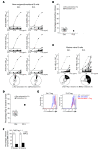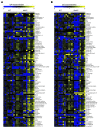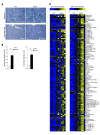Deficiency of base excision repair enzyme NEIL3 drives increased predisposition to autoimmunity
- PMID: 27760045
- PMCID: PMC5096910
- DOI: 10.1172/JCI85647
Deficiency of base excision repair enzyme NEIL3 drives increased predisposition to autoimmunity
Abstract
Alterations in the apoptosis of immune cells have been associated with autoimmunity. Here, we have identified a homozygous missense mutation in the gene encoding the base excision repair enzyme Nei endonuclease VIII-like 3 (NEIL3) that abolished enzymatic activity in 3 siblings from a consanguineous family. The NEIL3 mutation was associated with fatal recurrent infections, severe autoimmunity, hypogammaglobulinemia, and impaired B cell function in these individuals. The same homozygous NEIL3 mutation was also identified in an asymptomatic individual who exhibited elevated levels of serum autoantibodies and defective peripheral B cell tolerance, but normal B cell function. Further analysis of the patients revealed an absence of LPS-responsive beige-like anchor (LRBA) protein expression, a known cause of immunodeficiency. We next examined the contribution of NEIL3 to the maintenance of self-tolerance in Neil3-/- mice. Although Neil3-/- mice displayed normal B cell function, they exhibited elevated serum levels of autoantibodies and developed nephritis following treatment with poly(I:C) to mimic microbial stimulation. In Neil3-/- mice, splenic T and B cells as well as germinal center B cells from Peyer's patches showed marked increases in apoptosis and cell death, indicating the potential release of self-antigens that favor autoimmunity. These findings demonstrate that deficiency in NEIL3 is associated with increased lymphocyte apoptosis, autoantibodies, and predisposition to autoimmunity.
Figures









Comment in
-
Genetic cause of immune dysregulation - one gene or two?J Clin Invest. 2016 Nov 1;126(11):4065-4067. doi: 10.1172/JCI90831. Epub 2016 Oct 17. J Clin Invest. 2016. PMID: 27760052 Free PMC article.
Similar articles
-
Genetic cause of immune dysregulation - one gene or two?J Clin Invest. 2016 Nov 1;126(11):4065-4067. doi: 10.1172/JCI90831. Epub 2016 Oct 17. J Clin Invest. 2016. PMID: 27760052 Free PMC article.
-
Clinical Phenotypes and Immunological Characteristics of 18 Egyptian LRBA Deficiency Patients.J Clin Immunol. 2020 Aug;40(6):820-832. doi: 10.1007/s10875-020-00799-2. Epub 2020 Jun 6. J Clin Immunol. 2020. PMID: 32506362
-
Immunological phenotype of the murine Lrba knockout.Immunol Cell Biol. 2017 Oct;95(9):789-802. doi: 10.1038/icb.2017.52. Epub 2017 Jul 25. Immunol Cell Biol. 2017. PMID: 28652580
-
Leishmaniasis and Autoimmunity in Patient with LPS-Responsive Beige-Like Anchor Protein (LRBA) Deficiency.Endocr Metab Immune Disord Drug Targets. 2020;20(3):479-484. doi: 10.2174/1871530319666190807161546. Endocr Metab Immune Disord Drug Targets. 2020. PMID: 31389321 Review.
-
[B cell signal transduction and autoimmunity].Nihon Rinsho Meneki Gakkai Kaishi. 2002 Jun;25(3):244-54. Nihon Rinsho Meneki Gakkai Kaishi. 2002. PMID: 16578969 Review. Japanese. No abstract available.
Cited by
-
Multiomic profiling of new-onset kidney function decline: insights from the STANISLAS study cohort with a 20-year follow-up.Clin Kidney J. 2024 Jul 18;17(8):sfae224. doi: 10.1093/ckj/sfae224. eCollection 2024 Aug. Clin Kidney J. 2024. PMID: 39135941 Free PMC article.
-
Autoimmunity and Inflammation in CVID: a Possible Crosstalk between Immune Activation, Gut Microbiota, and Epigenetic Modifications.J Clin Immunol. 2019 Jan;39(1):30-36. doi: 10.1007/s10875-018-0574-z. Epub 2018 Nov 21. J Clin Immunol. 2019. PMID: 30465180 Review.
-
Oxidative Damage in Sporadic Colorectal Cancer: Molecular Mapping of Base Excision Repair Glycosylases in Colorectal Cancer Patients.Int J Mol Sci. 2020 Apr 2;21(7):2473. doi: 10.3390/ijms21072473. Int J Mol Sci. 2020. PMID: 32252452 Free PMC article. Review.
-
Clinical Implications of Digenic Inheritance and Epistasis in Primary Immunodeficiency Disorders.Front Immunol. 2018 Jan 26;8:1965. doi: 10.3389/fimmu.2017.01965. eCollection 2017. Front Immunol. 2018. PMID: 29434582 Free PMC article.
-
A digenic human immunodeficiency characterized by IFNAR1 and IFNGR2 mutations.J Clin Invest. 2017 Dec 1;127(12):4415-4420. doi: 10.1172/JCI93486. Epub 2017 Nov 6. J Clin Invest. 2017. PMID: 29106381 Free PMC article. Clinical Trial.
References
-
- Emlen W, Niebur J, Kadera R. Accelerated in vitro apoptosis of lymphocytes from patients with systemic lupus erythematosus. J Immunol. 1994;152(7):3685–3692. - PubMed
MeSH terms
Substances
Grants and funding
- RC2 HL102923/HL/NHLBI NIH HHS/United States
- UC2 HL102926/HL/NHLBI NIH HHS/United States
- UC2 HL103010/HL/NHLBI NIH HHS/United States
- K08 AI114968/AI/NIAID NIH HHS/United States
- RC2 HL102926/HL/NHLBI NIH HHS/United States
- UL1 TR001863/TR/NCATS NIH HHS/United States
- RC2 HL102924/HL/NHLBI NIH HHS/United States
- P01 AI061093/AI/NIAID NIH HHS/United States
- R01 AI042269/AI/NIAID NIH HHS/United States
- UC2 HL102923/HL/NHLBI NIH HHS/United States
- UC2 HL102924/HL/NHLBI NIH HHS/United States
- RC2 HL103010/HL/NHLBI NIH HHS/United States
- RC2 HL102925/HL/NHLBI NIH HHS/United States
- UC2 HL102925/HL/NHLBI NIH HHS/United States
LinkOut - more resources
Full Text Sources
Other Literature Sources
Medical
Molecular Biology Databases

